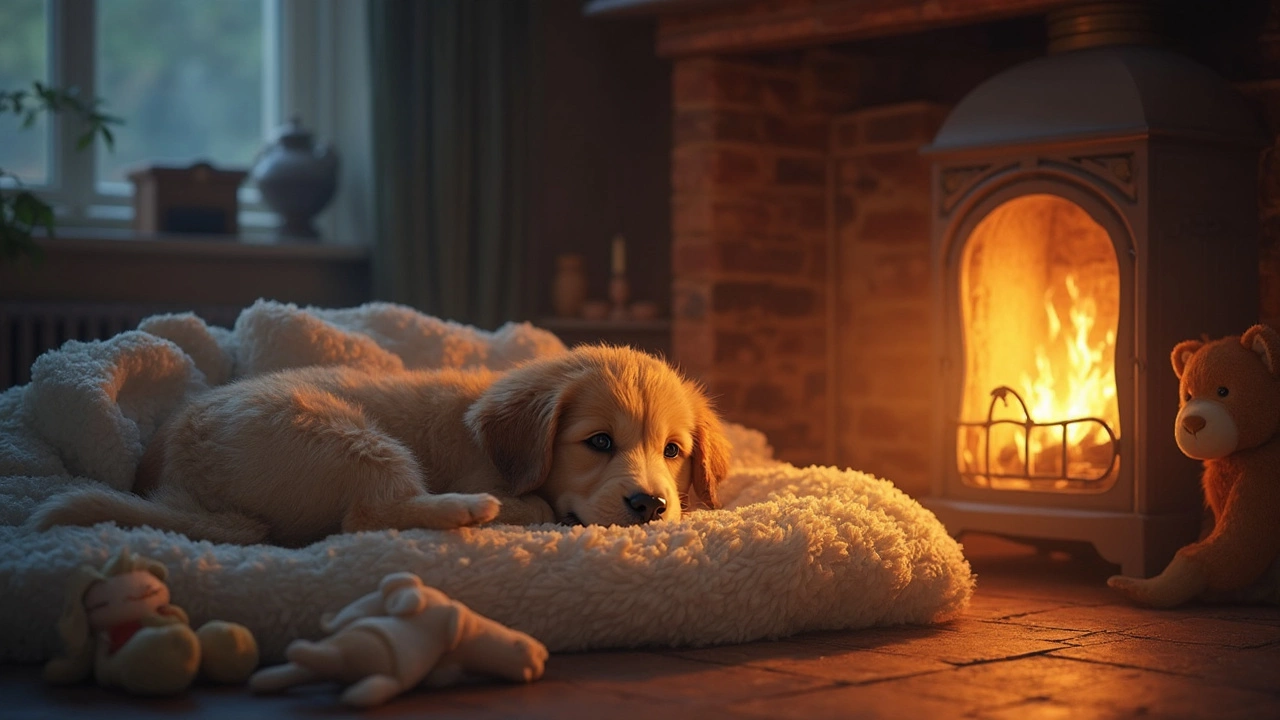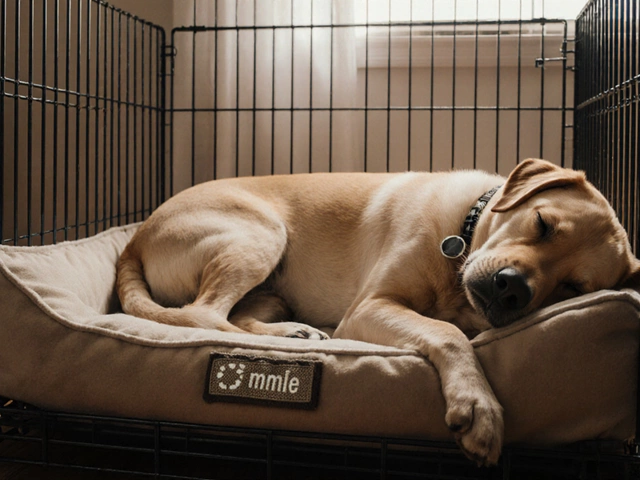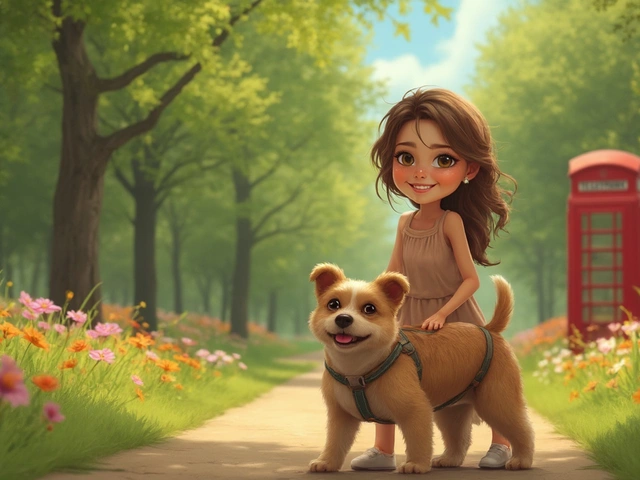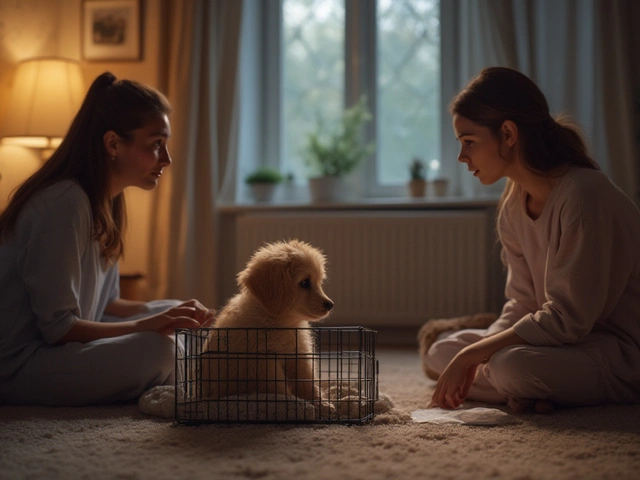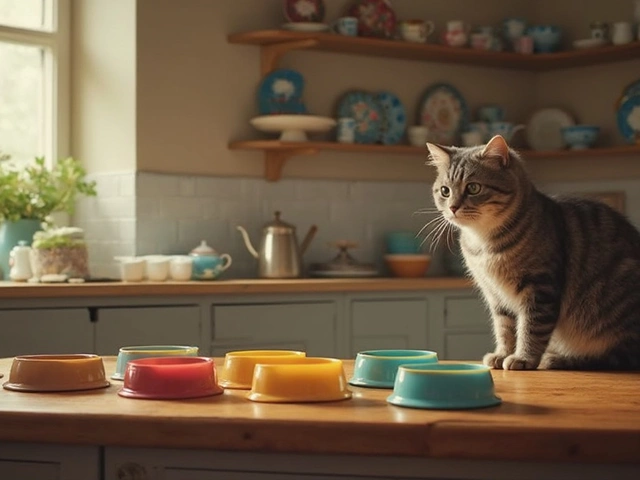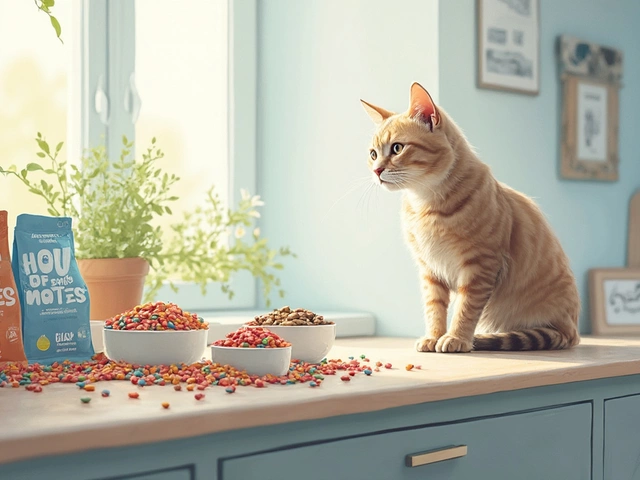Ever tried tiptoeing past your puppy’s crate at night and wondered, does he really need it pitch-black in here? You’re definitely not alone. A lot of new puppy parents worry if darkness messes with their little one’s sense of safety or sleep cycles, and honestly, there’s more to it than just flipping a switch off at bedtime.
Puppies, like human babies, need loads of good sleep—usually 18–20 hours every day when they’re very young. But the sleep they get isn’t all the same; it’s a mix of quick catnaps and deep snoozes. The environment you set up at night does play a part in how well your pup rests (and, let’s face it, whether you get any rest at all).
If your puppy whimpers as soon as the lights go out, it’s not because he’s trying to be dramatic. Young puppies haven’t learned that darkness equals safety and sleep. In fact, they’re wired to stick close to their litter or humans, and suddenly being alone in the dark can feel scary. But that doesn’t mean you need to leave every light blazing all night. Finding what helps your puppy feel secure makes a much bigger difference—and you’ll sleep better too.
- How Puppies Sleep: Nighttime Habits
- Does Light or Darkness Matter?
- When Puppies Fear the Dark
- Creating a Cozy Sleeping Spot
- Night Lights: Yay or Nay?
- Tips for a Peaceful Puppy Bedtime
How Puppies Sleep: Nighttime Habits
Figuring out how puppies actually sleep is a total game-changer for new dog owners. Right from the start, puppies rack up a lot more sleep hours than adult dogs—sometimes close to 20 hours every day. It’s not just about needing more shut-eye, though. Their bodies and brains are growing fast, and sleep fuels that growth.
Puppies don’t fall into a deep, all-night slumber like most humans hope for. Instead, they power through the night in short snooze cycles, with lots of shifting around and waking up for potty breaks. For young pups especially (under 12 weeks), expect them to wake up every 2-3 hours. This isn’t stubbornness—little bladders can’t hold it for long, and they’re hardwired to check that their world is still safe.
Nighttime habits can vary depending on the breed, age, and even what kind of day your puppy had. Super active pups might conk out faster, while timid ones may fuss at bedtime. If you pay attention to your puppy’s sleep patterns (how long they settle, how often they get up, or if they have trouble calming down), you’ll spot clues about what helps them rest easier.
- Newborns instinctively pile together for warmth and comfort.
- As puppies grow, they still look for that feeling of safety—either from you or a cozy crate.
- Most pups will nap on and off all night until about 4–6 months, when their sleep schedule starts to look more like an adult dog’s.
If your puppies seem restless at night, check whether they’re too hot, too cold, hungry, or just unsure in their new space. Sometimes, a bedtime routine (think: last potty break, a little cuddle, maybe a soft toy) can work wonders at getting your puppy to wind down and stay down for longer stretches.
Does Light or Darkness Matter?
So, does flipping off the lamp actually make a difference for puppies at night? The short answer: yes, but with a few twists. Puppies have pretty basic sleep needs, but light and darkness can play a bigger role than most people think when it comes to helping your pup rest well and feel safe.
First off, puppies don’t really need it to be pitch black to sleep. In fact, in nature, wild puppies huddle close to their mom and siblings, usually in a den that isn’t totally dark. Some animal studies show that constant light or constant darkness can mess with circadian rhythms—those are the internal clocks that tell your pup when it’s time to sleep or wake up. Letting a puppy sleep in complete darkness at night, while keeping days naturally brighter, actually helps set up a regular sleep schedule.
But here’s where real life comes in. Sudden darkness, especially in a new home, can stress a puppy out. Puppies see in low light way better than we do, but total darkness can trigger whining or restlessness because it feels unfamiliar.
- During the day, keep your puppy’s space bright and active.
- At night, a dark or dim area is best. Soft light from a nearby hallway or a small night light is fine if that helps your puppy settle.
- What matters most is consistency. Flicking lights on or off at random confuses your puppy and makes sleep training tougher.
One interesting tidbit—not all puppies are the same. Some sleep like a log with lights on, while others wake at the tiniest glow. If your puppies seem restless or anxious, tweaking the light might be an easy fix you haven’t tried.
| Lighting | Puppy Reaction |
|---|---|
| Pitch-dark | Best for sleep, but might cause anxiety for new pups |
| Dim Light | Usually calming; helps nervous puppies |
| Bright Light | Can interrupt melatonin production and sleep |
Bottom line: darkness is good for puppy sleep, but it’s the routine and vibe that really matter. Start with low light and see how your puppy reacts. Some pups just need a little glow to not feel lost in a new place.
When Puppies Fear the Dark
It’s actually pretty common for puppies to get anxious when the lights go out. In their first weeks, they’re used to being surrounded by siblings and their mom—even at night. Take away the pack, put them in a new home, and suddenly darkness can feel weird or even scary.
Here’s the science: puppies can’t see well in total darkness, just like us. And while dogs do have better night vision thanks to an extra layer in their eyes called the tapetum lucidum, young puppies still rely on scents and sounds to feel safe. When everything goes quiet and dark, some pups feel lost.
| Age | Common Fear Signs at Night |
|---|---|
| 6-10 weeks | Whining, barking, shaking |
| 10-16 weeks | Pacing, scratching at crate, howling |
So, is it about the dark itself or what the darkness means? Usually, darkness signals “you’re alone now.” That’s really what sets off the anxiety. Puppies will often cry, paw at their sleeping place, or even try to escape. Separation, not darkness alone, is usually the trigger.
If your puppy seems upset when it’s dark, look for these signs:
- Constant whining after lights go out
- Trying to leave the crate or room
- Not settling down (restless, circling, digging)
This doesn’t mean your pup is broken. Sleeping alone sometimes takes practice. You can usually help by keeping things consistent at bedtime, like having a favorite toy or your worn t-shirt close by.
You don’t have to keep them up all night or leave the TV blaring. Instead, aim for a calm, dim environment—not pitch black unless you’ve found your puppy really prefers it. And remember, most pups grow out of nighttime nerves once they learn their new space is safe.
If your puppy still struggles even after a few weeks, don’t be afraid to ask your vet or a trainer for tips. Sometimes, a little reassurance goes a long way.
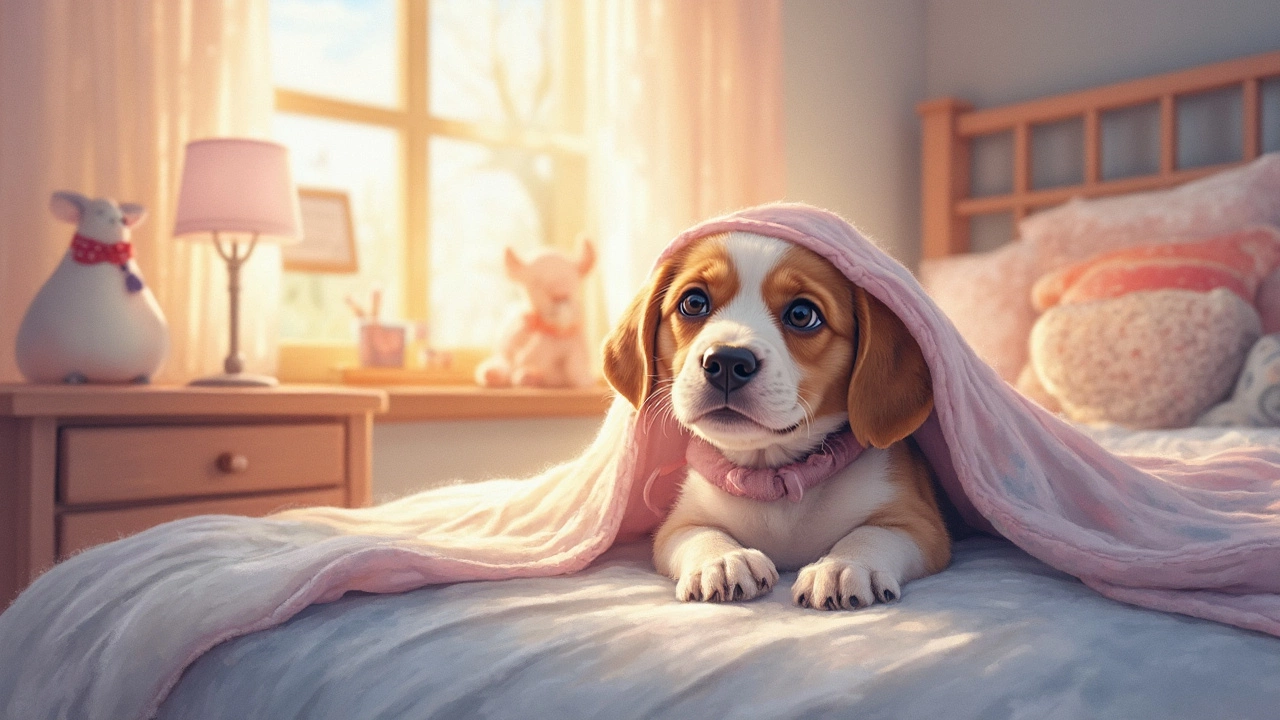
Creating a Cozy Sleeping Spot
The sleeping setup you create for your puppy matters way more than most people think. In their first few months, puppies feel safest in a small, secure area—think crate or pen—not out in the open. This gives them boundaries and stops them from wandering off or getting into something dangerous during the night.
You’ll want the space to be draft-free and just the right temperature. Vets recommend keeping it between 68–75°F (20–24°C). Puppies can’t regulate their body heat as well as adult dogs, especially small breeds, so don’t put the bed near a vent or in the direct path of sunlight.
Let’s break down what goes into making a super cozy sleep spot:
- Puppies feel safest with soft bedding. An easy-to-wash blanket or dog bed works, but skip anything with loose stuffing that’s easy to chew apart.
- A crate cover or towel over part of the crate helps block out light and noise, making the space feel like a den. Just make sure there’s still air flow.
- If your puppy just left his mom and littermates, you can help him feel less lonely with a plush toy or a snuggly item that has your scent on it. Some pros even recommend a ticking clock or a heat pack made for pets, so it mimics the feeling of sleeping in a pile of pups.
- No bowls, treats, or toys at bedtime—those just get in the way and can be a choking risk if your pup wakes up and starts chewing.
Research in animal behavior journals says puppies sleep more soundly and cry less at night when they have familiar objects nearby. If you bring home a blanket from the breeder or shelter, don’t wash it right away; the familiar smell helps your puppy settle in.
| Cozy Bed Checklist | Why It Matters |
|---|---|
| Soft bedding | Gives comfort and warmth |
| Covered crate sides | Blocks excess light and drafts |
| Something that smells like you | Helps with loneliness and stress |
| Safe plush toy | Mimics littermate comfort |
| Quiet area | Reduces nighttime noise and anxiety |
It’s tempting to bring your puppy into your bed right away, but most trainers say starting them off in their own space is better for everyone’s sleep in the long run. A cozy, inviting sleeping spot teaches your puppy that bedtime is nothing to fear—and gets you one step closer to peaceful nights.
Night Lights: Yay or Nay?
If you’re standing in the aisle at the pet store asking yourself if a night light is worth it for your new puppy, you’re not overthinking it. There isn’t a clear “one size fits all” answer, but there are good reasons some pet owners swear by them. Here’s what you need to know about using a night light and how it might make nights easier for both you and your dog.
Puppies don’t naturally need a light on at night—after all, in the wild, dogs would sleep with their pack in a dark den. But most puppies today don’t arrive with a bunch of siblings to snuggle. A small, steady night light can help ease nighttime anxiety for puppies that are adjusting to new surroundings or coping with separation.
Sleep studies in dogs are still pretty new, but early findings show some pups wake up more at night when exposed to bright lights. On the flip side, a super dark room can seem scary at first, especially for young puppies just separated from their litter. A dim night light gives just enough glow for comfort without messing with sleep rhythms.
If you’re considering night lights, don’t use one that’s too bright. Stick with low-wattage, warm-colored LED lights. Avoid anything with a blue tone—it can mess with melatonin (the sleepy hormone) in both humans and dogs.
- Plug the night light far enough from the crate that it’s gentle, not glaring.
- Always choose lights that don’t flicker, buzz, or hum.
- If your puppy seems just as nervous with the light on, try turning it off after a few nights—sometimes puppies just need to know you’re somewhere nearby, not a glowing bulb.
Here’s a quick look at how light choices affect puppy sleep:
| Light Setting | Puppy’s Likely Response |
|---|---|
| Pitch Dark | Safe for most, but can trigger separation anxiety at first |
| Soft Night Light | Usually helps anxious puppies, supports puppies in new homes |
| Bright Light | Disrupts sleep, makes restful snoozes tough |
So, should you use a night light? Try it if your pup seems uneasy or whines when left alone. If he settles down and snoozes better with it on, you’ve got your answer. If not, your puppy may just need a few nights to get used to sleeping like a pro, lights out.
Tips for a Peaceful Puppy Bedtime
Getting your puppy to settle down and snooze through the night can be a total game changer. Puppies thrive on routines, so a structured bedtime helps them (and you) get better, deeper rest. Here are some down-to-earth tips to create a chill nighttime vibe for your pup.
- Set a consistent bedtime: Try to put your puppy to bed at the same time every night. This helps their internal clock learn when it’s time to wind down for real sleep instead of just dozing off out of boredom.
- Evening potty break: Always let your puppy go outside right before bed to avoid those midnight wakeups. Puppies have small bladders and can’t hold it all night, especially under 4 months old.
- Limit food and water close to bedtime: Give your pup dinner at least two hours before lights out and stop water about an hour before sleep. This cuts down late-night bathroom trips.
- Use gentle background noise: Some puppies settle better with a little white noise or soft music. It blocks out random outside sounds that might freak them out.
- Keep the sleeping area simple and comfortable: Offer a cozy bed or crate with a soft blanket. Make sure it’s not too hot or cold—room temp between 68-72°F works for most puppies.
- Toss in a safe comfort item: Something that smells like you, like an old T-shirt, can calm an anxious puppy and help them feel more secure at bedtime.
- Dim the lights, don’t black it out: Puppies don’t need total darkness. A dim night light is fine if it helps them feel less alone, but try to avoid bright lights all night since that can mess with their sleep patterns.
Studies show that puppies with regular sleep routines and a relaxing environment wake up 34% less often during the night. It’s worth figuring out what works for your pup and sticking with it.
If your puppy fusses a lot or panics at night, it’s usually just part of the learning curve. Stick with the routine, offer comfort, and be patient. Before you know it, your little pal will be snoozing like a pro.
